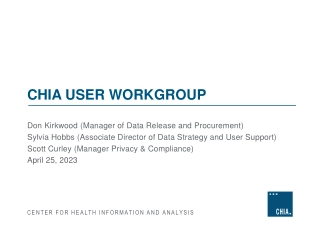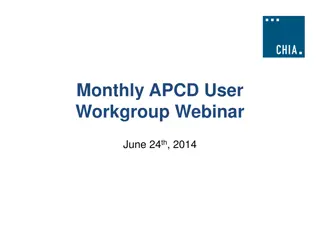Update on MA Center for Health Information & Analysis Case Mix User Workgroup - September 27, 2016
The MA Center for Health Information & Analysis held a User Workgroup meeting on September 27, 2016, providing updates on the status of the Case Mix FY15 readiness application. The session covered information on current release timeframes for various files, application processes, documentation availability, and reminders for users. The release includes data in LDS format for FY15 and old Levels format for FY04-FY14. Additionally, details on revised application forms and the MA APCD Release 5.0 Timeline were shared, along with application reminders for users. For further specifics and access to documents, visit the provided links.
Download Presentation

Please find below an Image/Link to download the presentation.
The content on the website is provided AS IS for your information and personal use only. It may not be sold, licensed, or shared on other websites without obtaining consent from the author.If you encounter any issues during the download, it is possible that the publisher has removed the file from their server.
You are allowed to download the files provided on this website for personal or commercial use, subject to the condition that they are used lawfully. All files are the property of their respective owners.
The content on the website is provided AS IS for your information and personal use only. It may not be sold, licensed, or shared on other websites without obtaining consent from the author.
E N D
Presentation Transcript
MA Center for Health Information & Analysis Case Mix User Workgroup September 27, 2016
Agenda Announcements Update on the status of Case Mix FY15 readiness Application Reminders CHIA Answers to User Questions Q&A
Case Mix FY15 Release Update We are accepting applications for all FY15 Case Mix files now. *CURRENT* RELEASE TIMEFRAMES FOR EACH FILE: [Applies to Non-Gov t Requests Only] Fixed Inpatient (HIDD) File with 5-digit zip codes for neighboring states END OF SEPTEMBER Emergency Department (ED) ready END OF OCTOBER Outpatient Observation (OOD) ready TBD
Case Mix FY15 Release Update Apply for all files now and we will fulfill them as they become available. FY15 Case Mix data in LDS format FY04-FY14 available in old Levels format (can request on the same application form) FY15 Release Documentation should be posted soon
Revised Application Forms Posted here: http://www.chiamass.gov/case-mix-application- documents/
MA APCD Release 5.0 Timeline: Apply for data NOW application forms are posted on the APCD website: http://www.chiamass.gov/application-documents\ Data is ready for release now Release documentation (including full data specifications and release documentation) has been posted to the APCD website: http://www.chiamass.gov/ma-apcd/ No change in fees or fee waiver provisions with this release
Application Reminders 1. Don t forget to upload CVs/Resumes for the core project team (even if you ve previously been approved for data) 2. Don t forget to upload your Research Methodology 3. Don t forget to upload IRB documentation (even if it s been determined that you are not subject to IRB review) 4. If you re uploading new/revised forms after your initial submission, don t forget to re-lock your project so we know that new materials are ready for review
Question: Both CHIA and AHRQ HCUP State Inpatient Data Administrators have been asked whether the numeric order of associated diagnosis and procedure codes in Hospital Inpatient Discharge Data (HIDD) ranks medical relevancy? Answer: Diagnosis and procedure codes hospitals collect in administrative data are primarily for billing based on the Centers for Medicare & Medicaid Services (CMS) and the National Uniform Billing Committee approved UB-04 (also known as the CMS-1450) claim form data elements. States have collected additional data elements not on the UB-04, such as race and ethnicity, to serve the needs of Government agencies and researchers. The Federal Agency for Health Research and Quality (AHRQ) has advised users of State HIDD that, unlike a clinical registry, no broad statement can be made about the medical relevancy of the ordering of billing data diagnosis codes for secondary use. Payers have specific billing rules which vary. For example, a Medicare rule in the use of diagnosis codes is that the sign/symptoms that prompt the ordering of diagnostic tests should be used in the absence of a diagnosis. Payers may also have specific types of code edits associated with medical necessity or changes in those edits associated with different payment models, such as bundled payments.
Question: In comparison to FY2014 HIDD, what percentage of discharge records in FY2015 of had 15 or more diagnosis codes? Comparison of FY2014 to FY2015 HIDD Distribution of the Number of Diagnosis Codes by Number of Discharges 180,224 FY2014 FY2015 FY2014 DX Limit 45,056 FY2015 DX Limit Lifted 11,264 Number of Discharges Answer: In FY2015, 165,087 records (20.7%) have at least 15 diagnosis codes. 2,816 704 176 44 (cell suppression at 11 discharges) 11 1 8 15 22 29 Number of Diagnosis Codes 36 43 50 57 64 72 105
Question: FY2015 HIDD contains principal, admitting diagnosis and discharge diagnosis. Are these diagnosis fields populated for all records and are the diagnosis fields ever populated with the same diagnosis codes? Answer: No, the fields are not populated for all records. The FY2015 HIDD contains 796,835 discharge records, 0.01% do not have a principal or admitting diagnosis and 10.6% do not have a discharge diagnosis. Yes, there are instances when the principal diagnosis field matches the other diagnosis fields with the highest match (87.6%) with the discharge diagnosis. Percent Match Between Principal DX and other DX Codes Percent Completeness of Diagnosis Codes Principal Diagnosis 796,766 Records 99.9% Principal DX Match Admitting Diagnosis 712,486 Records 99.9% 87.6% of Discharge DX Discharge Diagnosis 712,486 Records 52.1% of Admitting DX 89.4% 42.1% of Discharge and Admitting DXs At Least 5 Associated Diagnosis 589,588 73.9% Note: Data anomaly 1.9% of Associated DXs
Question: With the lifting of the limit on diagnosis codes, did E-Code information increase on the types of activities performed while injured? Answer: Yes, injuries of 792 different types of activities and mechanisms appear in the FY2015 data. Below is an example of how specific these activities are. American flag or touch football American tackle football Baseball Basketball Bike riding Bowling Boxing Building and construction Cheerleading Climbing base jumping Cooking and baking Cross country skiing Digging, shoveling and raking Floor mopping and cleaning Food preparation and clean up Frisbee Gardening and landscaping Golf Grilling and smoking food Grooming and shearing an animal Gymnastics Horseback riding Ice hockey Ice skating Lacrosse and field hockey Racquet and hand sports Rappelling Residential relocation Roller skating (inline) and skateboarding Rowing, canoeing, kayaking, rafting and tubing Rugby Running Snow (alpine) (downhill) skiing, snowboarding Soccer Surfing, windsurfing and boogie boarding Swimming Trampoline Underwater diving and snorkeling Vacuuming Walking an animal Walking, marching and hiking Water skiing and wake boarding Water sliding Wrestling Yoga Aerobic and step exercise Calisthenics Caregiving involving bathing Caregiving involving lifting Exercise machines for cardiorespiratory conditioning Rough housing and horseplay Spectator at an event Civilian activity done for income or pay Military activity Animal care Climbing, rappelling and jumping off Computer technology and electronic devices Other cooking and grilling Dancing and other rhythmic movements External motion Ice and snow Cardiorespiratory exercise Muscle strengthening exercises Sports and athletics played as a team or group Sports and athletics played individually Person providing caregiving Property/land maintenance Water and watercraft External cause status Specified sports and athletics activities Free weights Other household maintenance Other personal hygiene activity Pilates Push-ups, pull-ups, sit-ups Laundry Exercise machines for muscle strengthening Personal bathing and showering Mountain/rock/wall climbing Martial arts Physical games generally associated with school recess
Question: After the Institute of Medicine Report on Dying in America, Medicare proposed paying providers for time spent counseling do-no- resuscitate (DNR) and palliative care patients. In FY2015, was any change seen in data on DNR and comfort care patients? Answer: Yes, there was an 18.5% increase in use of the flag for DNR patients and 15% increase in comfort care patients. Also, the quality of data improved. Blanks decreased by 8% and confirmation that the patient did not have DNR or comfort care improved by 27% Comfort Care Measures Only Do-Not-Resuscitate Order Please Take Important Note 2265 15015 2015 The Flag fields (such as DNR status and Homelessness status) should not be used alone when there are also V-Codes to describe conditions and circumstances. For example, in FY2015, using V4986 you will find 60,387 distinct discharges (mostly Medicare patients) coded as Do Not Resuscitate. 12015 1765 1515 9015 1265 1015 6015 765 515 3015 265 15 15 2011 2012 2013 2014 2015 2011 2012 2013 2014 2015 Decrease in Blanks Increase in Confirming No DNR or Comfort Care 700015 300015 600015 250015 500015 200015 400015 150015 300015 100015 200015 50015 100015 15 15 2011 2012 2013 2014 2015 2011 2012 2013 2014 2015
Question: Aside from gender, race/ethnicity, and ZIP Code, are there other data in the FY2015 that can be used to analyze the social determinants of health? Answer : The lifting of diagnosis codes increased the availability of V-Codes related to the social determinants of health. Aside from child birth related codes and other medical conditions, below are some of the top V-Codes from men and women in FY2015 related to the social determinants of health. V- Code V1582 V4986 V6284 V667 V8541 V600 V8542 V620 V8543 V603 V463 V8539 V8530 V8531 V8525 V4984 V8544 V1584 V6285 V1542 Description Personal history of tobacco use, presenting hazards to health Do not resuscitate status Suicidal ideation Encounter for palliative care Body Mass Index 400-449, adult Lack of housing Body Mass Index 450-499, adult Unemployment Body Mass Index 500-599, adult Person living alone Wheelchair dependence Body Mass Index 390-399, adult Body Mass Index 300-309, adult Body Mass Index 310-319, adult Body Mass Index 290-299, adult Bed confinement status Body Mass Index 600-699, adult Personal history of contact with and (suspected) exposure to asbestos Homicidal ideation Personal history of emotional abuse, presenting hazards to health Females 51234 37231 10654 10283 10799 3587 5728 2570 4288 3244 2544 1917 1530 1472 918 941 989 86 361 794 Males 59067 25134 11388 9582 5930 7846 2641 4157 2086 2146 2163 1167 1404 1388 939 735 536 1133 839 372
Question: Was there a decrease in inpatient discharges by any specific age group? Answer: The largest decrease was for the age group 18 years old and younger. Number of Discharges by Patients' Age Groups Comparison for FY 2014 (N=785,485) and FY 2015 (796,835)
Questions? Questions related to APCD : (apcd.data@state.ma.us) Questions related to Case Mix: (casemix.data@state.ma.us) REMINDER: Please include your IRBNet ID#, if you currently have a project using CHIA data
Call for Topics and Presenters If there is a TOPIC that you would like to see discussed at an MA APCD or Case Mix workgroup, contact Adam Tapply [adam.tapply@state.ma.us] If you are interested in PRESENTING at an MA APCD or Case Mix workgroup, contact Adam Tapply [adam.tapply@state.ma.us] You can present remotely from your own office, or in-person at CHIA.























